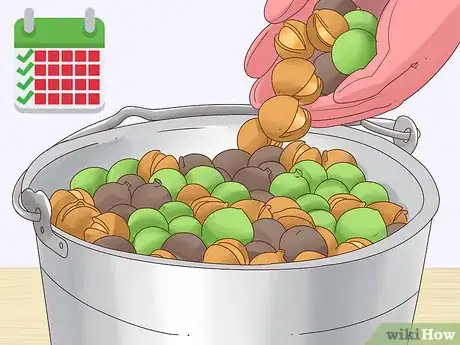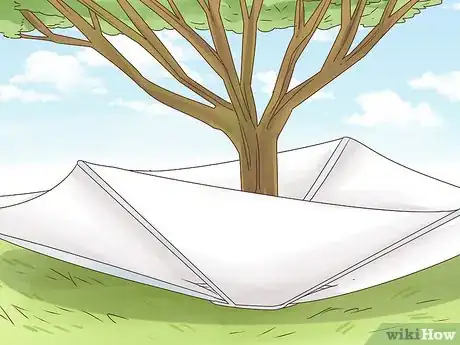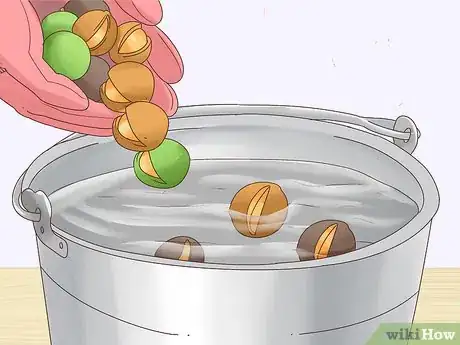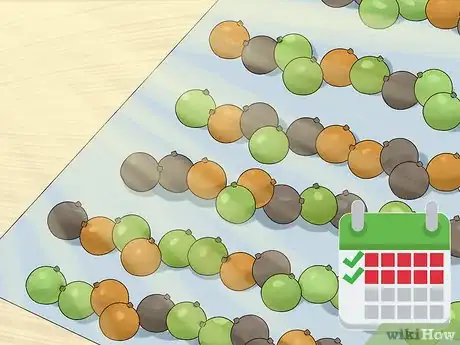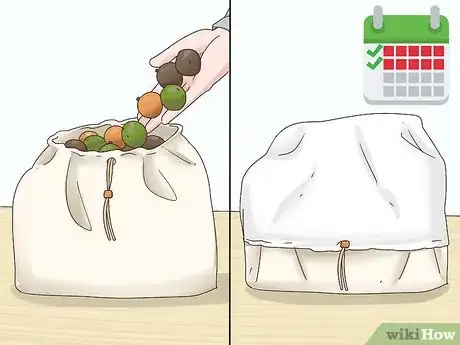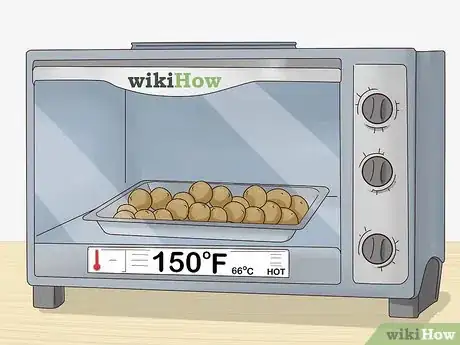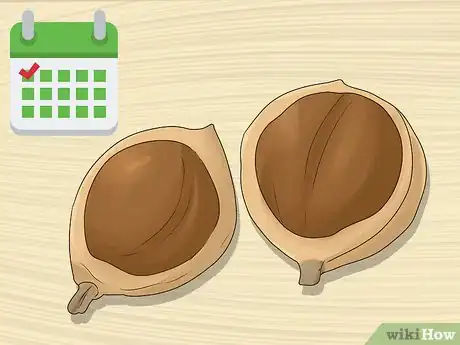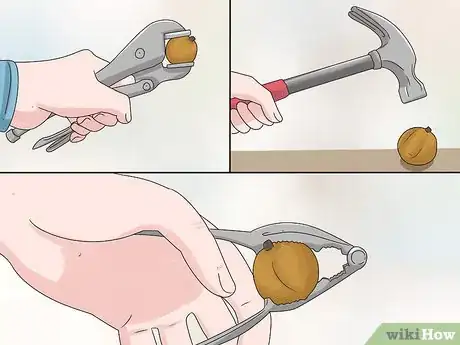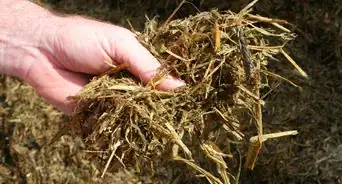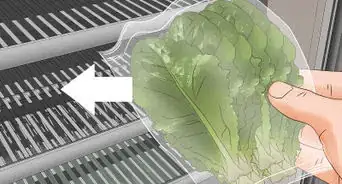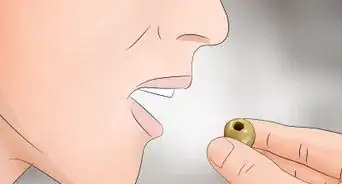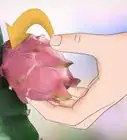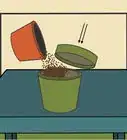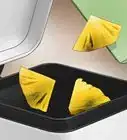This article was co-authored by wikiHow Staff. Our trained team of editors and researchers validate articles for accuracy and comprehensiveness. wikiHow's Content Management Team carefully monitors the work from our editorial staff to ensure that each article is backed by trusted research and meets our high quality standards.
This article has been viewed 45,054 times.
Learn more...
Macadamia nuts, also known as Queensland nuts, maroochi nuts, and bush nuts, are fruits of the macadamia tree, native to Australia. And although hand-harvesting your nuts is the simplest step of the harvesting process, there are a few more things you need to do before you can reap their health benefits in their delicious, roasted form.
Steps
Collecting Your Nuts
-
1Collect your macadamia nuts every 2 to 4 four weeks during wet weather. During harvesting season—late fall (Autumn) to spring—focus your efforts on periods when weather is wet. When the weather is dry, collect your nuts less often—every 1 to 2 months. [1]
- Wet weather is more likely to cause mold, germination, and rat or pig damage. Always make it a top priority to get your nuts inside during this weather.
- Healthy macadamia trees begin bearing nuts after 6 to 7 years. They will produce around 30 to 50 pounds (14 to 23 kg) of nuts by 10 years of age. This amount gradually increases as your tree ages from this time.
-
2Lay a tarp beneath your tree to catch ripe nuts. Ripe nuts will fall to the ground naturally. Never shake your tree, as it can dislodge immature nuts. You can also hand-pick ripe nuts that are within reach. Touch the outside of the nuts to determine ripeness—if they are sticky, they are not ripe.
- Use a long pole to dislodge mature nuts in hard-to-reach areas. To determine ripeness, look for shrunken husks that push out the nut.
Advertisement -
3Watch out for signs of disease during nut collection. Look out for spots on leaves, twig dieback, and bronzed or yellow leaves. The most common diseases in macadamia trees are macadamia root rot (Kretzschmaria clavis), trunk canker (Phytophthora cinnamomi), and macadamia quick decline (MQD). The first two can be caused by prolonged drought and poor drainage, while the third is typically caused by stresses such as low pH and nutritional problems.[2]
- Prune your trees in the spring and remove diseased and dying branches from their canopy. Remove remaining nuts on the trees after pruning.[3]
- Apply mulch after harvesting your nuts, and avoid piling it against the tree's trunk—this can cause disease.
- While these diseases don’t always affect macadamias, throw out any nuts that show signs of rot or damage and prune damaged regions of your trees.[4]
-
4Test your macadamia nuts for their ripeness by placing them in water. Ripe macadamia kernels float in fresh water—crack open a sample from your nuts and remove the kernel to test it. Another sign of ripeness is a chocolate brown color inside of the husk—if it's white, the nut isn't ripe yet. Finally, ripe nuts are dry on the outside, while unripe nuts are sticky and don't pull away from the husk easily.
- Macadamia nut ripening varies greatly depending on the location, variety, and season. This goes for single trees, too: some of the nuts might take several months to ripen, while others ripen in much shorter periods of time.
Drying Your Whole Nuts
-
1Separate the cracked nuts from the whole ones. Locate nuts with a cracked outer husk—separate these for dehusking. Any that are whole need to be dried.
- Older nuts are brown and younger are green. However, it's more efficient to separate based on cracks.
-
2Dry your ripe whole nuts in the shade for 2 weeks when the weather is dry. Air-drying your nuts in the shade (either indoors or outside away from direct sunlight) reduces their moisture content and prevents them from turning rancid. Always dry your nuts as soon as possible after harvesting them or when they fall to the ground.
- For cracked nuts, skip the drying process and de-husk them as soon as possible. Nut husks hold moisture, which is why dehusking is a high priority.
-
3Layer the nuts between a cloth for indoor drying. Place all of your uncracked nuts onto a cloth, and then layer another cloth on top. Leave them there for 1 to 2 weeks, and check up on them intermittently.
- The cloth layers absorb moisture from the inner nuts and shrink them so that they don't stick to the husk. This makes for easier removal.
-
4Dry your nuts a second time in the oven at 100 to 150 °F (38 to 66 °C). Before putting your nuts in the oven, place them in a shallow pan and gently stir them around occasionally to make sure they're evenly dried. If they are drying properly, you can hear the nuts shake in their husk when you rattle them. Heat the nuts for approximately 12 hours. Afterwards, crack a few open—brittle husks that crack easily (and cleanly) are sufficiently dry.
- Keep an eye out for signs of cooking—which can damage the nuts—such as smoke.
- A second dry is standard practice at warehouses that commercially prepare macadamia nuts.
- Once your whole nuts are completely dry, skip to 3.2.
Dehusking and Storing Your Nuts
-
1Remove the husk from your cracked nuts within 24 hours of harvesting. The husk will easily peel off in nuts that are cracked. If you leave the husks on, your nuts are more susceptible to mold development. Not only that, processing time increases as the husk hardens.
-
2Remove whole husks using Vice grips, hammers, and nutcrackers. Nuts that haven't cracked are tougher to open. Using your tool of choice, create a crack in the husk. Afterwards, you should be able to easily peel it off with your hands.
- Ripe nuts have a chocolate brown color within the inner husk. If you notice the inside of the husk is white, it's not ripe.
-
3Remove any nuts that are damaged or less than 1⁄2 inch (1.3 cm) in diameter. This means cracks, discolored husks, and worm holes. Remember: these quality control standards are for the inner nuts, not the husks on the outside.
- Smaller nuts can still be used, but these requirements are standard for warehouses that process them commercially. If you want the absolute best quality, follow the same standards
-
4Store de-husked nuts somewhere dry for 2 to 3 weeks. A cool, dry location is ideal for macadamia nut storage prior to roasting. If you're transporting dehusked nuts, it's fine to let them spend 1 day at most in bags or boxes. Always air-dry them prior to storage.
- Other more effective storage options include a slotted or wire rack, or in layers of cloth.
- Roast your nuts as soon as possible.
Things You'll Need
- Garden pruners
- Mulch
- Layers of cloth
- Tarp
- Shallow pan
- Vice grip, hammer, or nutcracker
- Slotted or wire rack
Warnings
- Common pests for macadamia trees include ambrosia beetles, broad mites, long-horned grasshoppers, narrow-winged katydids, southern green stink bug, koa seed worms, macadamia shot borer, Hawaiian flower thrips, and Red-banded thrips.[5]⧼thumbs_response⧽
References
- ↑ http://www.extento.hawaii.edu/kbase/crop/crops/i_macada.htm
- ↑ http://era.daf.qld.gov.au/id/eprint/1964/10/mac-problemsolver_Part2.pdf
- ↑ https://plantvillage.psu.edu/topics/macadamia/infos
- ↑ http://www.extento.hawaii.edu/kbase/crop/crops/i_macada.htm
- ↑ http://www.extento.hawaii.edu/kbase/crop/crops/i_macada.htm
